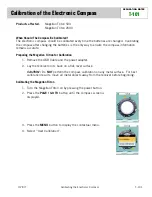
| 27
Operation |
HS80/MX575C User Manual
Common commands and messages
¼
Note:
When selecting your baud rate and message types use the following formula and
example to calculate the bits/sec for each message and then sum the results to determine
the baud rate for your required data throughput. Transmitting the commands listed
in “Commands” on page 27 and monitoring the messages in “NMEA 0183 and other
messages” on page 28 requires that the PC serial communication port be connected to
the RS-232 interface wires of the 18-Pin antenna cable of the MX575C (see “PC to MX575C
interface diagram” on page 53). The HS80 requires this optional cable.
Message output rate * Message length (bytes) * bits in byte = Bits/second
(1 character = 1 byte, 8 bits = 1 byte, use 10 bits/byte to account for overhead)
Example:
Message
Rate
Bytes
Bits in byte
Bits/sec
GPHDT
10
20
10
2000
GPROT
5
18
10
900
GPHDG
1
33
10
330
GPGGA
1
83
10
830
GPZDA
1
38
10
380
Total
4440
The next sections provides brief descriptions of common commands and messages for the
HS80/MX575C.
Commands
Command
Description
$GPMSK
Tune beacon to specific frequency
$JAGE
Specify maximum DGPS (COAST) correction age (6 to 8100
seconds)
$JAPP
Query or specify receiver application firmware
$JASC
Specify ASCII messages to output to specific ports (see
ASCII messages in Table 3-3)
$JBAUD
Specify RS-232, RS-422 (output) communication rate
$JBIN
Specify binary messages to output to specific ports (see
Table 3-4)
$JDIFF
Query or specify differential correction mode
$JGEO
Query or specify SBAS for current location and SBAS
satellites
$JI
Query unit’s serial number and firmware versions
$JOFF
Turn off all data messages
$JQUERY,GUIDE
Query accuracy suitability for navigation
Summary of Contents for HS80/MX575C
Page 1: ...ENGLISH HS80 MX575C User Manual...
Page 55: ...988 10221 001...
































